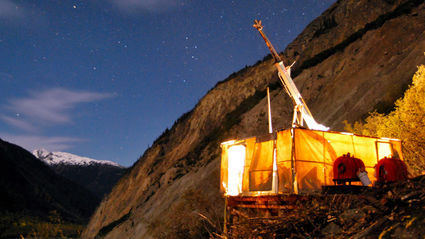Exploring beyond the vast KSM deposits
North of 60 Mining News – June 21, 2019
Last updated 9/25/2020 at 5:05pm

Seabridge Gold Inc.
Now that drills have outlined 106 million ounces of gold, 45.9 billion pounds of copper, 614 million oz of silver and 607 million lb of molybdenum (measured, indicated and inferred) in the four main deposits at KSM, Seabridge is shifting its focus to some of the opportunities identified across the property.
With the four main deposit at KSM – Kerr, Sulphurets, Mitchell and Iron Cap – advanced to the mine feasibility stage, Seabridge Gold Inc. June 18 said it is focusing its 2019 exploration program on discovery targets beyond the vast copper-gold resources delineated so far across this property in British Columbia's Golden Triangle.
The four KSM deposits host 2.98 billion metric tons of measured and indicated resources averaging 0.52 grams per metric ton (49.7 million ounces) gold, 0.21 percent (13.9 billion pounds) copper, 2.8 g/t (265 million oz) silver and 54 parts per million (312 million lb) molybdenum; plus 4.56 billion metric tons of inferred resource averaging 0.38 g/t (56.3 million oz) gold, 0.32 percent (32 billion lb) copper, 2.4 g/t (349 million oz) silver and 32 ppm (295 million lb) molybdenum.
A prefeasibility study (PFS) completed in 2016 detailed a mine for KSM that would produce an average of 540,000 oz gold, 156 million lb copper, 2.2 million oz silver, and 1.2 million lb molybdenum annually over a 53-year mine life.
Since the completion of the PFS, Seabridge has focused much of its exploration on expanding Iron Cap to the size needed to consider moving this deposit earlier into the proposed mine plan for KSM.
With this goal achieved – for more information see Iron Cap expansion mission accomplished – Seabridge is exploring beyond the mine plan.
"Our first priority at KSM has been to ensure that the project is ready for final feasibility efforts when a partner is secured," said Seabridge Gold Chairman and CEO Rudi Fronk. "Now that this objective has been accomplished, we are intent on improving our understanding of the entire project and its district-scale potential by addressing the many opportunities that remain, using the extraordinary bank of knowledge we have accumulated over the past decade."
The Kerr, Sulphurets, Mitchell and Iron Cap deposits are exposed on the erosional margin of the Sulphurets Thrust Fault at KSM.
This year's discovery exploration will evaluate the potential for additional gold-copper porphyry systems below the thrust fault and follow up on high-grade epithermal gold intercepts near the Sulphurets deposit.
Seabridge's exploration at KSM since 2005 has recognized the potential for undiscovered porphyry deposits west of the exposed deposits and below the STF system.
High-definition magnetic surveys and historical drilling have identified porphyry style targets separate from but in the vicinity of the Mitchell and Iron Cap deposits.
The key to this season's program is to use deep penetrating geophysical techniques west of these deposits and under the STF to refine potential drill targets.
This year's geophysical work will focus on improving resolution on deep targets and generating discrete zones for future drilling.
While anything turned up at these deep discovery targets would likely be developed long after mining begins at KSM, Seabridge said early identification of these potential deep porphyry deposits could avoid conflict with proposed surface infrastructure.
In addition to the deep porphyry targets, Seabridge plans to further investigate potential epithermal occurrences on the margins of the Sulphurets deposit.
One hole drilled in this area last year, S-18-81, included a two-meter intercept averaging 1,580 g/t gold (nearly 51 oz per metric ton) and 209 g/t silver. The next hole, S-18-82, cut 12.2 meters of 5.83g/t gold and 7.2g/t silver, and 3.95 meters of 18.5 g/t gold and 30.6 g/t silver.
Seabridge said these unexplained occurrences on the margins of Sulphurets were not followed up at the time of their discovery due to other priorities.
In addition to the marginal discovery, more than 10 holes have been drilled within Sulphurets since the last resource was calculated for the deposit in 2012.
These holes, which tapped mineralization north, west and below Sulfurets, are expected to expand the resource of this deposit.
–SHANE LASLEY











Reader Comments(0)